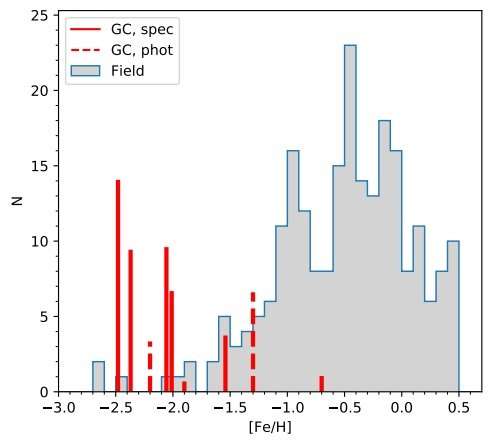January 16, 2018 report
Astronomers conduct detailed chemical analysis of eleven globular clusters

Astronomers have performed abundance measurements for 11 globular clusters in the galaxies NGC 147, NGC 6822, and Messier 33. The new study, presented January 9 in a paper published on arXiv.org, could improve our knowledge about chemical composition of stellar populations in the universe.
Globular clusters are spheroidal collections of tightly bound stars orbiting galaxies. For astronomers, they are natural laboratories that enable studies on stellar and chemical evolution. Therefore, detailed abundance analyses of globular clusters could help us answer many fundamental questions in astrophysics.
With that aim in mind, a team of astronomers led by Soeren S. Larsen of the Radboud University in Nijmegen, the Netherlands, has analyzed spectra of globular clusters in the galaxies NGC 147, NGC 6822, and Messier 33, all located in the Local Group. The spectroscopic data were obtained with the HIRES (High Resolution Echelle Spectrometer) spectrograph on the Keck I telescope in Hawaii and with the UVES (UV-Visual Echelle Spectrograph) on the Very Large Telescope (VLT) in Chile.
The analysis allowed the researchers to determine detailed chemical abundances of eleven globular clusters.
"We have presented new integrated-light measurements of chemical abundances for 11 globular clusters in NGC 147, NGC 6822, and Messier 33," the astronomers wrote in the paper.
In general, the researchers found that globular clusters in dwarf galaxies like NGC 147 tend to be relatively metal-poor, compared both with their counterparts in the halo of the Milky Way galaxy and with the field stars in the respective galaxies. However, they emphasized that no globular clusters with a metallicity [Fe/H] below −2.5 have yet been found, either in the Milky Way or among the clusters they have observed so far.
The study reveals that the stellar abundance ratios of alpha-elements to iron behave differently as a function of metallicity in the dwarf galaxies and Messier 33. The analysis conducted by Larsen's team indicates that the metal-poor clusters described in the paper are alpha-enhanced at about the same level as globular clusters in the Milky Way. However, the researchers note that while the more metal-rich globular clusters in the dwarf galaxies have ratios of alpha-elements to iron similar to that of the sun, those in Messier 33 remain alpha-enhanced.
Moreover, the astronomers found that alpha-elements in the globular clusters in Messier 33 follow patterns similar to those seen in the globular clusters in our galaxy. This finding allowed the authors of the paper to assume that the Messier 33 halo underwent relatively rapid chemical enrichment, dominated by Type II Supernova nucleosynthesis.
In concluding remarks, the researchers noted that at low metallicities, the abundance patterns suggest that globular clusters in the Milky Way, dwarf galaxies, and Messier 33 experienced similar enrichment histories or processes. Furthermore, they emphasize that at higher metallicities, the lower levels of alpha-enhancement in the globular clusters in dwarf galaxies resemble the abundance patterns observed in field stars in nearby dwarfs.
More information: Detailed abundance analysis of globular clusters in the Local Group: NGC 147, NGC 6822, and Messier 33, arXiv:1801.03140 [astro-ph.GA] arxiv.org/abs/1801.03140
Abstract
We present new abundance measurements for eleven GCs in the Local Group galaxies NGC 147, NGC 6822, and Messier 33. These are combined with previously published observations of four GCs in the Fornax and WLM galaxies. The abundances were determined from analysis of integrated-light spectra, obtained with HIRES on the Keck I telescope and with UVES on the VLT. We find that the clusters with [Fe/H]<-1.5 are all alpha-enhanced at about the same level as Milky Way GCs. Their Na abundances are also generally enhanced relative to Milky Way halo stars, suggesting that these extragalactic GCs resemble their Milky Way counterparts in containing significant fractions of Na-rich stars. For [Fe/H]>-1.5, the GCs in M33 are also alpha-enhanced, while the GCs that belong to dwarfs (NGC 6822 SC7 and Fornax 4) have closer to Solar-scaled alpha-element abundances, thus mimicking the abundance trends observed in field stars in nearby dwarf galaxies. The abundance patterns in SC7 are remarkably similar to those in the Galactic GC Ruprecht 106, including significantly sub-solar [Na/Fe] and [Ni/Fe] ratios. In NGC 147, the GCs with [Fe/H]<-2.0 account for about 6% of the total luminosity of stars in the same metallicity range, a lower fraction than those previously found in the Fornax and WLM galaxies, but substantially higher than in the Milky Way halo.
© 2018 Phys.org



















